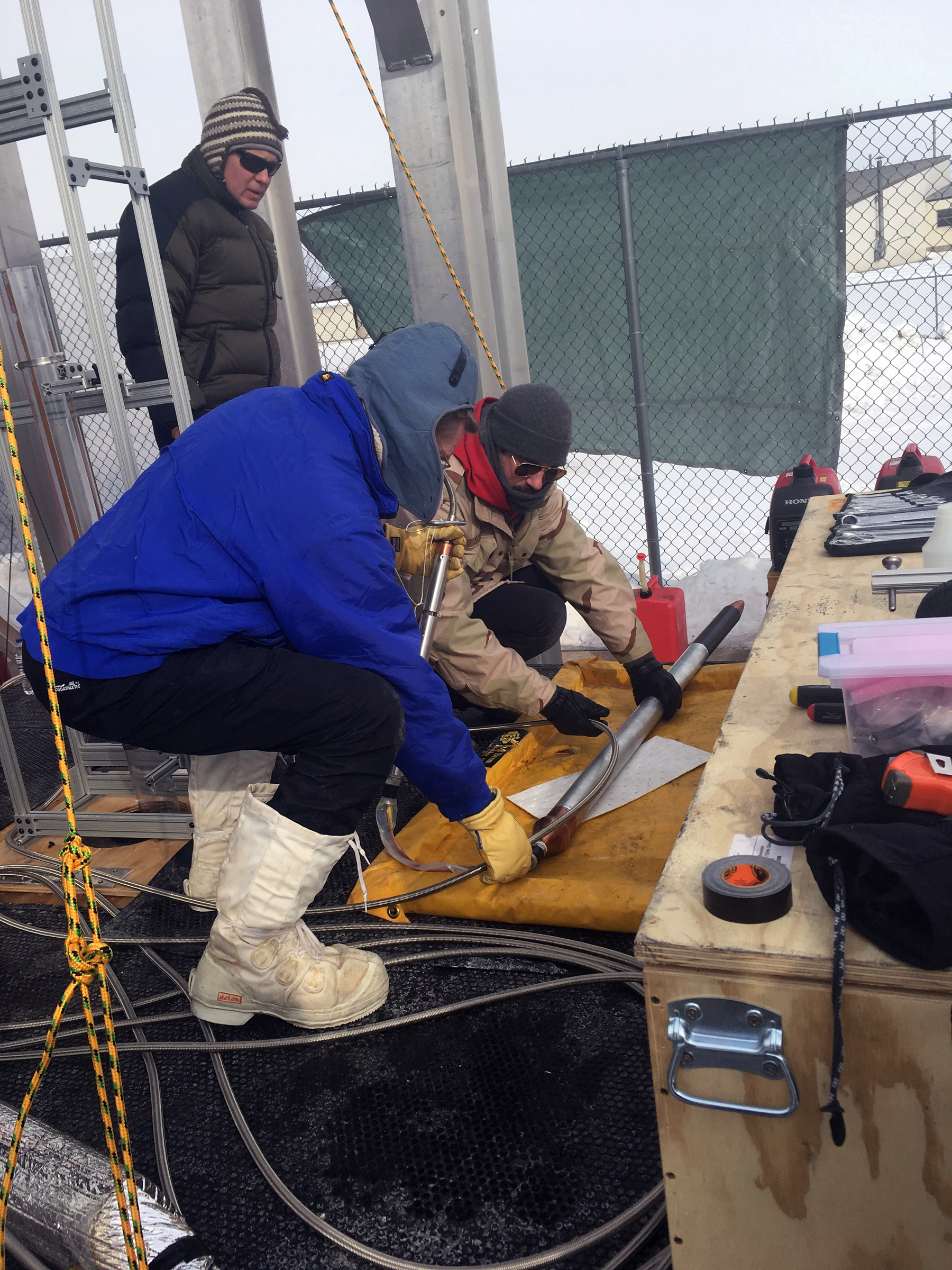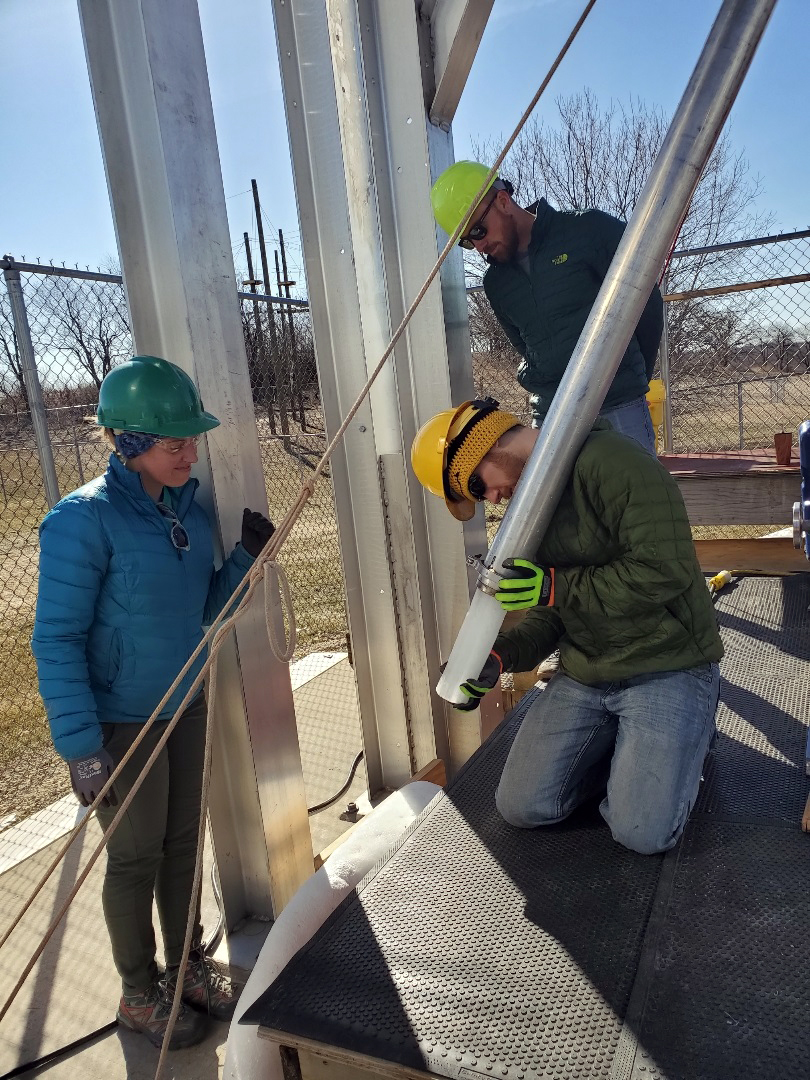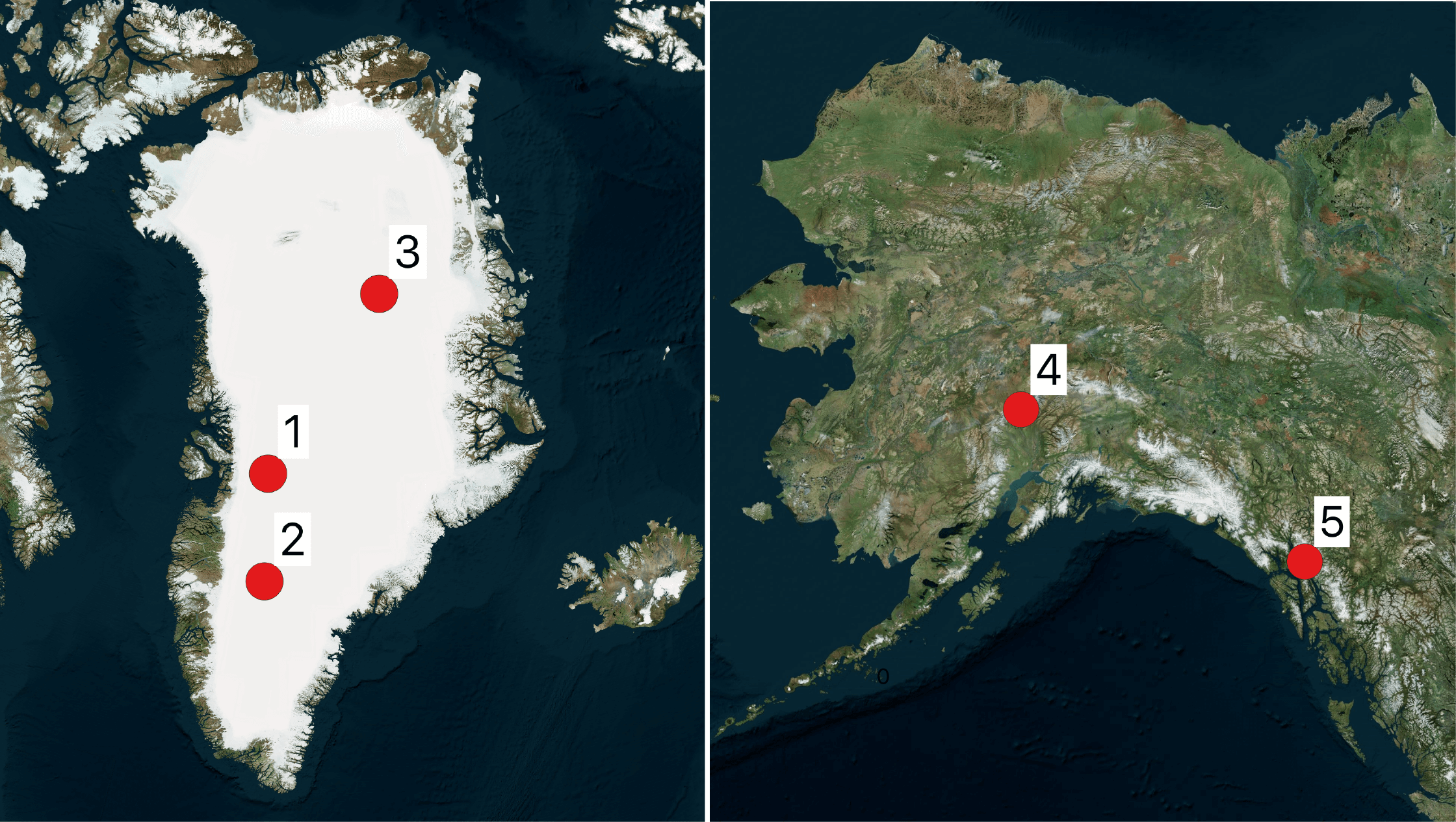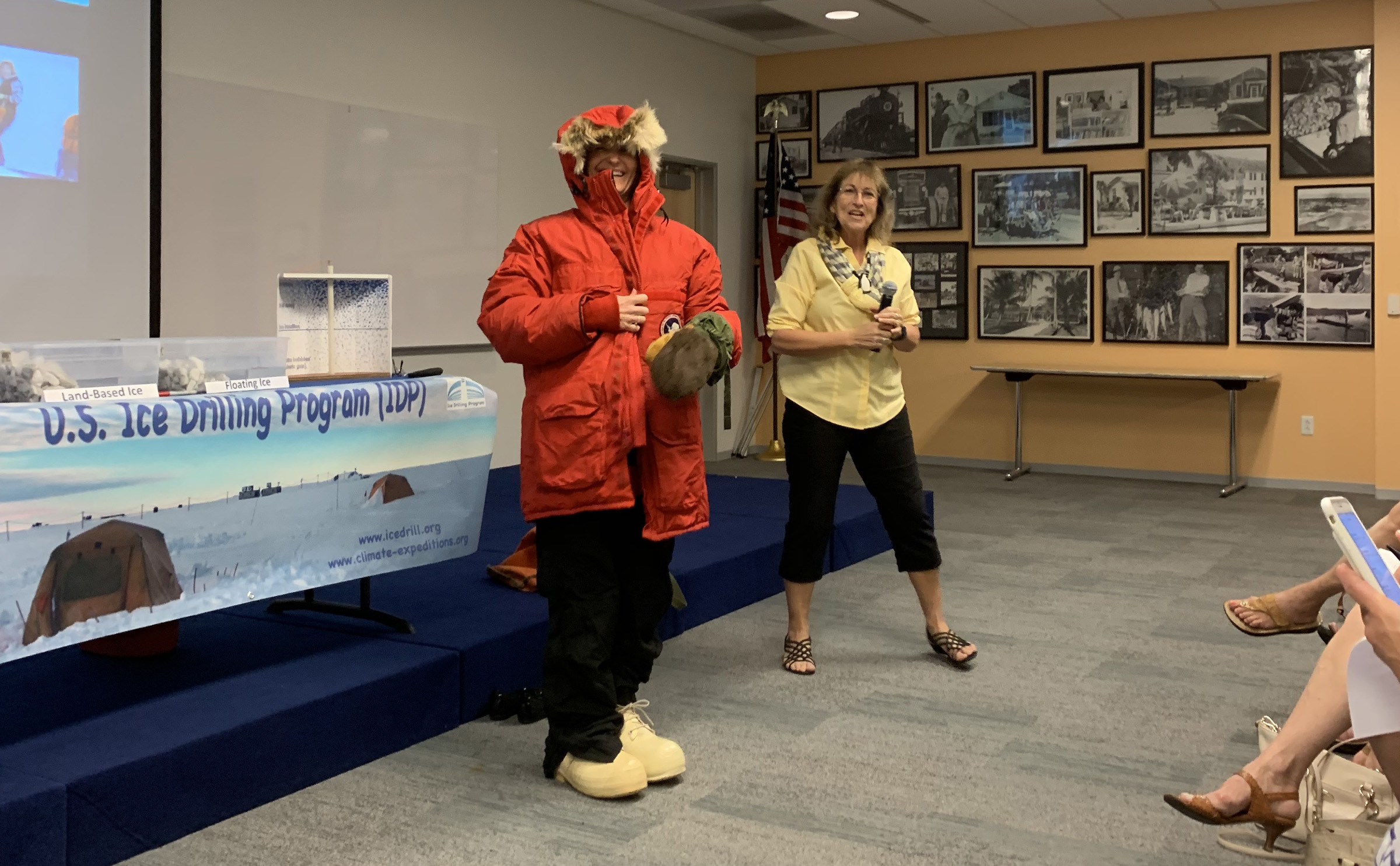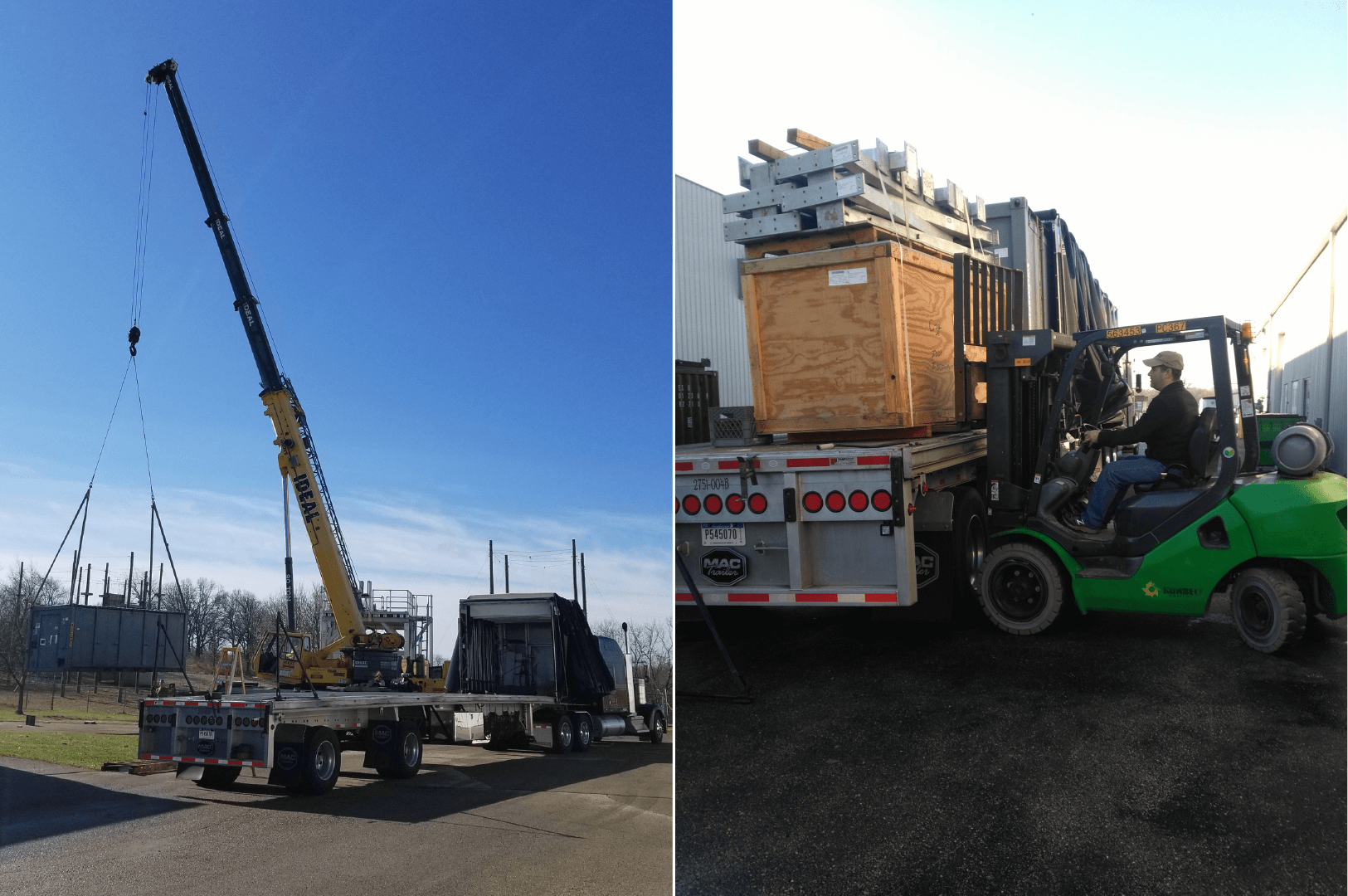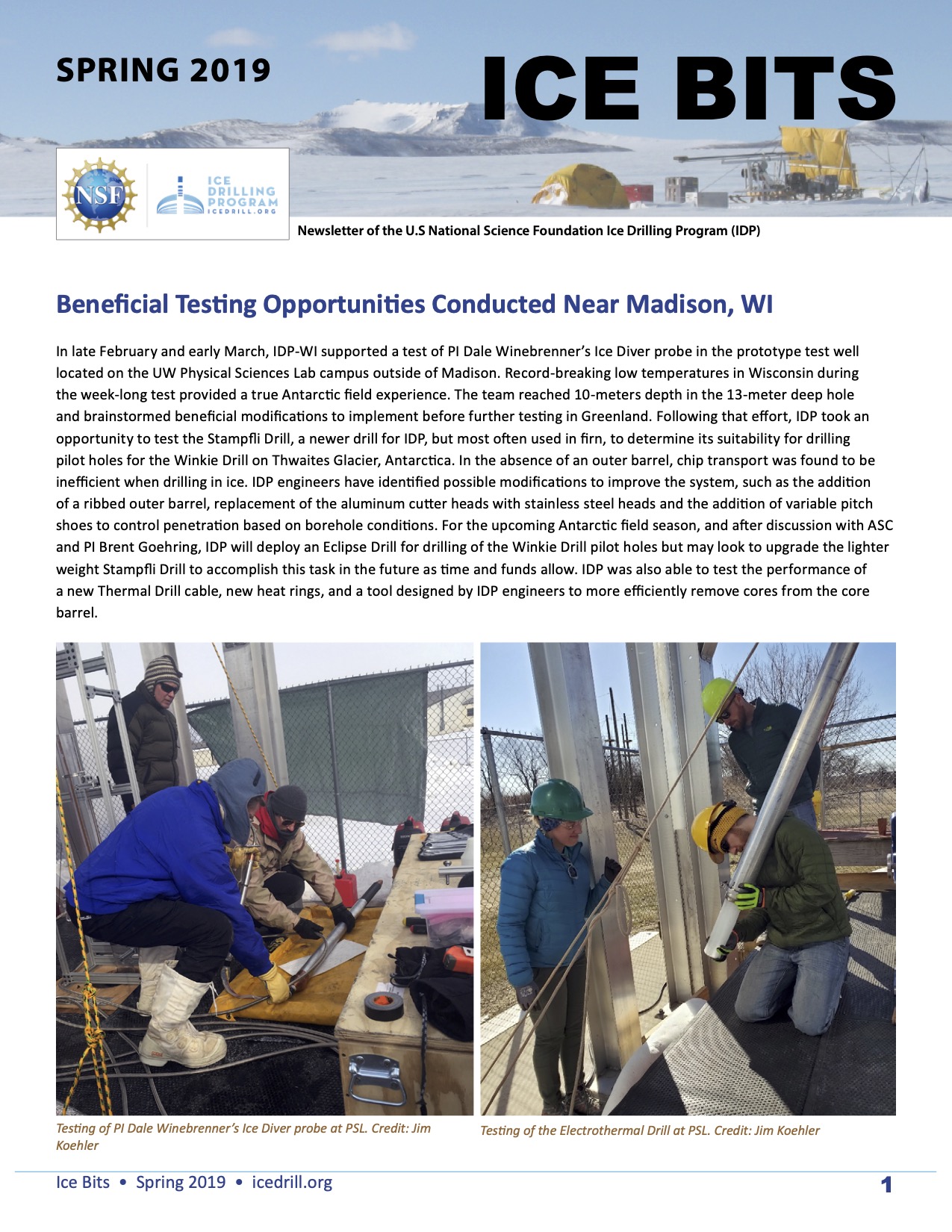Beneficial Testing Opportunities Conducted Near Madison, WI
- Stampfli Drill
- Winkie Drill
- Eclipse Drill
- Thermal Drill
In late February and early March, IDP-WI supported a test of PI Dale Winebrenner's Ice Diver probe in the prototype test well located on the UW Physical Sciences Lab campus outside of Madison. Record-breaking low temperatures in Wisconsin during the week-long test provided a true Antarctic field experience. The team reached 10-meters depth in the 13-meter deep hole and brainstormed beneficial modifications to implement before further testing in Greenland. Following that effort, IDP took an opportunity to test the Stampfli Drill, a newer drill for IDP, but most often used in firn, to determine its suitability for drilling pilot holes for the Winkie Drill on Thwaites Glacier, Antarctica. In the absence of an outer barrel, chip transport was found to be inefficient when drilling in ice. IDP engineers have identified possible modifications to improve the system, such as the addition of a ribbed outer barrel, replacement of the aluminum cutter heads with stainless steel heads and the addition of variable pitch shoes to control penetration based on borehole conditions. For the upcoming Antarctic field season, and after discussion with ASC and PI Brent Goehring, IDP will deploy an Eclipse Drill for drilling of the Winkie Drill pilot holes but may look to upgrade the lighter weight Stampfli Drill to accomplish this task in the future as time and funds allow. IDP was also able to test the performance of a new Thermal Drill cable, new heat rings, and a tool designed by IDP engineers to more efficiently remove cores from the core barrel.
Field Support to 2019 Arctic Projects
- Fieldwork
- Hand Auger
- Stampfli Drill
- Thermal Drill
The second quarter saw the start of the 2019 Arctic field season. IDP is providing support to the following projects:
(1) The Quantifying Heat/Mass Structure and Fluxes through the Full Thickness of Greenland's Percolation Zone project (PI Harper; NSF award #1717241) will collect several shallow firn cores in western Greenland using a hand auger and Sidewinder kit. The cores will be used to quantify firn density, and the resultant boreholes will provide access for temperature logging of the firn column. The goal of the multiyear project is to use a combination of shallow and deep cores/boreholes to quantify the structure, thermal state, and heat fluxes through the full thickness of the firn column across a transect spanning western Greenland's percolation zone. The researchers are using their own hot water drill to drill the deep boreholes.
(2) The Refreezing in the Firn of the Greenland Ice Sheet 2019 project (PI Rennermalm; NSF award #1604058) will use a hand auger and Sidewinder kit to collect several shallow firn cores from the southwestern sector of the Greenland Ice Sheet to investigate the stratigraphy, density, temperature, and liquid water content of the firn cover. The project's goal is to better understand how the surface meltwater generated in the summer makes its way from its location on the ice sheet to the ocean. Two competing but not mutually exclusive theories are 1) the meltwater percolates into the ice sheet pores and is stored for a relatively long time. 2) The initial infiltrating meltwater refreezes at shallow depth in the firn, forming a hard pan that prohibits further infiltration. The project will test these two hypotheses through a combination of fieldwork, remote sensing from satellites, and modeling.
(3) The Partnerships for Polar Science Education and Outreach in Greenland (JSEP) project (PI Virginia; NSF award #1748137) is a multicultural polar science outreach program for high school students from Greenland, Denmark, and the USA. The program brings US students together with Danish and Greenlandic students in Greenland, where the group will spend several weeks studying the causes and consequences of Arctic environmental change. As part of the program, a hand auger will be used to expose the students to firn science (observing stratigraphic, density, and temperature changes with depth) at EastGRIP.
(4) The EAGER: Exploration of the Denali Basal Ice Core Archive project (PI Kreutz; NSF award #1806422) will return to their 2013 ice core drill site and use the Stampfli Drill to collect a 30- to 50-meter long core. The researcher's objective is to understand the recent and past changes in summer temperature, snow accumulation, atmospheric circulation, and pollution in the context of the last 2000 years of natural variability in the North Pacific. In 2013 the researchers collected twin 208-meter long ice cores to bedrock from the summit plateau of Mt. Hunter in Denali National Park. This season's 30- to 50-meter long core will be used to update the climate record from 2013 to 2019 and help aid in the interpretation of the deeper ice.
(5) The Thermal Drill Testing with the Juneau Icefield Research Program (JIRP) project is an internal IDP project. The Electrothermal drill, aka the "Thermal drill", is a mechanical ice coring drill based on the agile 4-Inch drill but with the addition of an electrically heated ring that enables coring in temperate ice that is close to the pressure melting point. Following planned system upgrades in PY 2018, including a new 300-meter long cable, new heat rings and an ethanol delivery mechanism, IDP is conducting a three-week test of the Electrothermal Drill system in Alaska in conjunction with other JIRP activities and established logistics. Following the test, IDP will inspect and repair the Electrothermal Drill equipment and make any necessary modifications.
IDP Subglacial Access Working Group Science Planning Workshop
- Meetings/ Workshops
- Long Range Plans
- Publications
On March 29-30, 2019 the Ice Drilling Program Subglacial Access Working Group Science Planning Workshop was held at the Washington Dulles Marriott Suites Worldgate hotel in Herndon, Virginia. The goal of the interdisciplinary ice community workshop was to identify future Arctic and Antarctic drilling sites for subglacial science, the ice drilling technology that is needed, and the timeline over the coming decade for advancing subglacial science on multiple frontiers.
IDP Subglacial Access Working Group conveners Slawek Tulaczyk and Jill Mikucki worked with workshop participants in generation of the following white papers:
- Assessment of East Antarctic Ice Sheet sensitivity to warming and its potential for contributions to sea level rise
- Access Drilling Priorities in the Ross Ice Shelf Region
- Subglacial Access Working Group (SAWG): Access Drilling Priorities in Greenland
The targeted future drilling sites and dates will be included in the planning matrices of the updated IDP Long Range Science Plan 2019 - 2029, which will be completed in June. The white papers are available on the IDP webpage at https://icedrill.org/about/meetings.shtml.
Education and Public Outreach (2019 Spring)
- Education/ Outreach
- Meetings/ Workshops
Louise Huffman spoke to the Women's Cultural Alliance (WCA) at the Naples (FL) Daily News Office Community Room on February 6, 2019. She presented ice core science and why it is important, especially for those living in Florida, to an audience of 50 men and women.
Planning the June School of Ice in Denver continues. Huffman traveled to Colorado to meet with representatives from each of the venues: the NSF Ice Core Facility, the University of CO-Boulder/INSTAAR, and the Antarctic Support Contract. During this trip, she also held a meeting with Dr. Matt Siegfried to finalize a new hands-on inquiry lab activity based on subglacial lake science. The activity will be unveiled and tested at the School of Ice this summer before making it widely available on the icedrill-education.org website.
The MECC and Other Antarctic Cargo Returns
- Fieldwork
- Intermediate Depth Logging Winch
- Sediment Laden Lake Ice Drill
- DISC Drill
In early April, IDP-WI coordinated with staff at Port Hueneme to return cargo from Antarctica. Returned equipment included the Hand Augers used during the 2018-2019 season, the Intermediate Deep Logging Winch and the Sediment Laden Lake Ice Drill. In addition, several crates of DISC Drill equipment and the MECC (Mobile Expandable Container Configuration) machine shop returned after over a decade on the ice. The DISC Drill equipment and MECC were slowly removed from WAIS Divide on flights of opportunity.
Ice Drilling Support for NSF Polar Proposals
- Funding Opportunities/ Solicitations
- Education/ Outreach
If you are preparing a National Science Foundation (NSF) proposal that includes any kind of support from IDP, you must include a Letter of Support from IDP in the proposal.
Researchers are asked to provide IDP with a detailed support request three weeks prior to the date the Letter of Support is required. Early submissions are strongly encouraged.
Scientists who seek to include IDP education and outreach activities associated with U.S. ice coring or drilling science projects should contact Louise Huffman at Louise.T.Huffman@Dartmouth.edu during their proposal preparation stage.
For further information on requesting IDP support, visit our website at https://icedrill.org/requesting-field-support or contact us at IceDrill@Dartmouth.edu.

